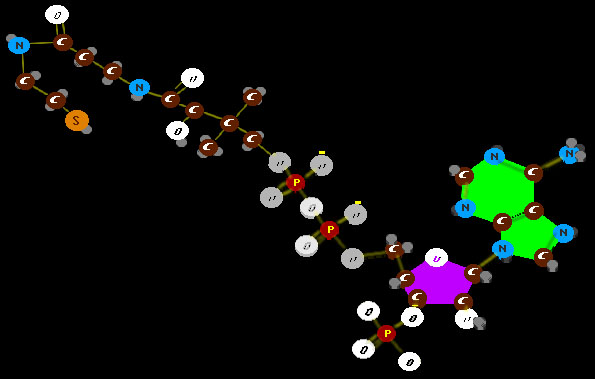 |
|||
|
Metabolism
Taking liberties with the term, metabolism, is a back to the broth view of chemistry - looking at the art without regard to the museum that houses it. Just keep in mind that these chemistries do not want to happen. The chemicals would rather diffuse away into lonely chemical oblivions. But enzymes, proteins with whips and teeth, herd those chemicals, keeping tight hold on them. This is where we are going, more or less, the crossroads of life. Actually, the crossroads is a traffic circle called the "Citric Acid Cycle" or paying homage - Krebs' Cycle.
We will see how sugars (immediate energy), amino acids (building substance as proteins), and fat (long term power storage and waterproofing) all come together at this crossroads. The key is think in two's - two carbons, that is. Everything depends on having a common exchange unit (Europe is still working on that one, no?). The common unit of exchange in metabolism is a pair of carbons. One carbon has four attachment points. So, if we have one
carbon attached in the simplest way to another C-C then each carbon has three open
attachments - unsatisfied attachment points are not going to happen. Hydrogen has just one attachment so you can satisfy the C-C situation with 6 hydrogens Oxygen has two attachment points, so one carbon could be happy with two oxygens O=C=O better known as CO2. If you fulfill one of oxygen's linkages with a hydrogen, you have a very handy alternative to hydrogen single openings HO- call Hydroxyl. You can satisfy its thirst with one more hydrogen and get hydroxyl hydrogen HO-H, and rename it H2O or water. Or tack one -OH hydroxyl onto that two carbon unit (with six hydrogens called ethane) to get H3C-CH2-OH hydroxy ethane or ethanol . Chill the H2O, saturate it with CO2, and mix in the CH3-CH2OH with a twist of lime... no, wrong, pathway ...
But look how basic that common chemistry is. Even the twist of lime, citrate, is right at our very core. A turn of the citrate cycle will accept units of two carbon size and spin them off into protein, fat, or sugars and do so utilizing protein fat or sugars. The process will chop off CO2 and H2O, as less leaves the cycle than comes in. It is more of a meat grinder at times as stuff comes in and goes out all chopped to CO2 and H2O. The cycle generates cell money - energy as it goes around - in two curriencies (both RNA based of course).
But this is serious cell money. How about a credit card? Something that can promise ATP without actually being ATP? That takes NADs? Two, in fact.
The red arrow shows where a phosphate can be added, not for energy, as here it wouldn't work that way. It allows a second form of NAD to be treated apart. The two promisory notes are NAD and NADP. At the level of the Citric Acid Cycle, the subtle reactions of twisting chemical shapes so as to set them up for the CO2 cleaver, require more subtle energy transfers and some way of controlling direction, as the turn of this wheel can either send small components back up pathways to reconstitute the larger elements (anabolism, building fats, proteins and complex sugars and starches from smalled primitive components, which requires cell money to happen - versus - catabolism, taking the big stuff and chopping it up to small pieces to make fuel to burn and generate cell money). The extra phosphate in the NADP version has no chemical significance other than as a recognition tag for those enzymes that assist anabolism - the reverse of breakdown for energy - the use of energy to build up complex molecules. The P as in Production. The other, NAD, is used for processes of catabolism . This duel form of cell energy credit does not drive the direction of each process, just the rates which can be independent. It is all about control. Metabolism is like a carnival. There are all sorts of things going on that seem to have their own purpose but they do all contribute to and draw on the whole.
BEGIN AT GLUCOSE : Let's start at glucose. We have already shown how, for a price, the hexokinase protein, or more specifically enzyme (a protein that manipulates other substances), Ph-attens up glucose to be chopped into two halves of 3 carbons each. The cost is 1 ATP => 1 ADP (chop off one ). First it traps the glucose.
Then it chomps down and splits the phosphate off ATP putting it instead on the glucose. A series of enzyme mouths pass this sugar along chewing it into distorted sugar shapes with other names until one enzyme named Aldo (Aldo Lase) finally chews through the sugar cleaving it into two smaller fragments of 3 carbons each. Aldo spits the pieces out.
The two fragments are thus carefully chaperoned through a cascade of enzymes at the cost of one more ATP=>ADP. The cost of initiating this ride toward the citric acid cycle is - therefore - 2 ATP. However, as we approach the cycle, the ride itself GENERATES energy - cell money - to the count of 4 ATP so that there is a net GAIN of 2 ATP (and some hydrogen- hey whatawedo with hydrogen?).
It is a roller coaster ride that costs the cell 2 ATP to seat each sugar rider but which pays 4 back to the cell when ridden. The cell gains 2 overall. The glucose is getting spent of its energy into less and less energetic forms of three carbon molecules. At the end of this ride the three carbon molecules emerge as Pyruvate ('ate' and 'ic acid' are synonyms). Pyruvic acid is the last stop on the roller coaster before the grand Fun Wheel - the Citric Acid Cycle. To recap, starches or animal equivalent of starches (strings of sugar --- cotton candy!!) gets eaten and consumed generating SOME energy. The ride is a breathless one. No oxygen is consumed. So far the process is anerobic - performed without requirement of O2. It's called glycolysis. Wanna ride? Or how about the next thrill ride? ______________
Some cells have to stop here, unable to have the small 3 carbon riders board the citrate cycle . The pyruvate still has a lot of fuel left and could spend it, but just not in certain cells. Yeast, needs to get rid of this pyruvate as it has no pass for the Citrate Cycle. It splits off CO2 and uses the hydrogen as it converts the remains to CH3-CH2-OH known as ethyl alcohol. Do this in a slurry of sugar called malt, and you get beer. Do this in dough and the dough rises from the CO2 (the alcohol cooks away). Animals are not big on getting self inebriated as alcohol affects the nervous system and
getting frothy from CO2 can be troublesome. So, as do some single cell critters which make cheese, animals - that's you bunky - avoid the CO2 chop step and rather than make a two
carbon alcohol, make the 3 carbon acid called lactate (or lactic acid): Think of it this way, certain tissues take a bite out of the bread and toss the rest away. Thus the LIVER becomes an organ of locomotion in that it gets the job of dealing with the spent lactic acid. It can get the lactate into the citrate cycle and burn it for more ATP & NAD but it makes sense to use some of that additional energy to send the lactate backward on the roller coaster to make glucose and send the new glucose to the muscle via the blood stream. You see? Not all chemistry steps happen in every cell. The advantage of this lesser route of metabolism in strenuous muscle activity is that when the muscle is tensed, blood flow is diminished and oxygen delivery diminished. Muscle action can go on while breath holding. The energy drop is more favorable to development of power.
But let's stay with the sugar roller coaster. Once we get to pyruvate or get pyruvate back from some other cell's dump of lactic acid, we need an escort. One CO2 gets chopped off as the chaperone "Coenzyme-A" gets latched on. This handle will drag the new two carbon hunk into the cycle. The two carbon piece is essentially acetic acid which would be
But actually, a better and easier bond to snip uses a sulphur handle. As sulphur has two handles and oxygen has two handles we find these two swapped frequently. which changes the name to acetyl (ahh-suh-teel) and thus we get acetyl-coenzyme-A. Again notice the RNA (ADP-like) main hunk with a tow line segment and a hook of sulphur that will grab by swapping on some other molecule's oxygen.
Acetyl Co A is a biggie. Very important. Co-A is a major guide of molecules through certain processes, but this one is the most critical of any. This Acetyl CoA is the single molecule pivot of life, the very axis of our chemical existence which not only steps metabolism into the fire of oxidation but is a common building element to most processes. Fats are built of strings of these two carbon units and so are always formed in even numbered carbon chains lengths. The Citrate Cycle takes in units these units of two linked carbons and splices them onto 4 carbon units to build six carbon units whose chemical formula looks like a letter 'E'. Let's take a peek at it (it here at the Mitochondria section of the cell).
As the wheel begins with adding 2 carbons to a 4 carbon unit we get Citrate with six carbons. The six carbon structure gets tweaked and twisted and eventually snipped to a 5 carbon length molecule which is one of three key links to amino acid production. The 5 carbon unit gets snipped to a 4 carbon chain which gets tweaked and twisted into the 4 carbon molecule which can be added to another acetyl to go around again. Each cycle spins off carbon as CO2 and directly generates some ATP (cell money - energy molecules) and a whole bunch of energy credit as NAD sopped with hydrogen which will be cashed for ATP. It does so by burning hydrogen with oxygen to make water (H+ OH => HOH or H2O). Now haven't they been talking about making cars that run clean by burning hydrogen and only having water as exhaust? Aerobic metabolism has been doing that since the big soup. What's the problem with cars doing it? BOOM! It's that control thing. Process has to be controlled and the energy linked to something useful as is done by the cell which actually burns hydrogen in a series of subatomic steps!!! It involves electron pumps and proton membrane filters and a whole bunch of way out machinery which we have no idea as to how to copy - yet. The cycle above shows the batteries of ATP which are generated or rendered on cash in of the NAD credits.
|
| [P.O. Home] [Topics] [Muscle] [Basic Science] [Metabolism] |
|
|
|
|
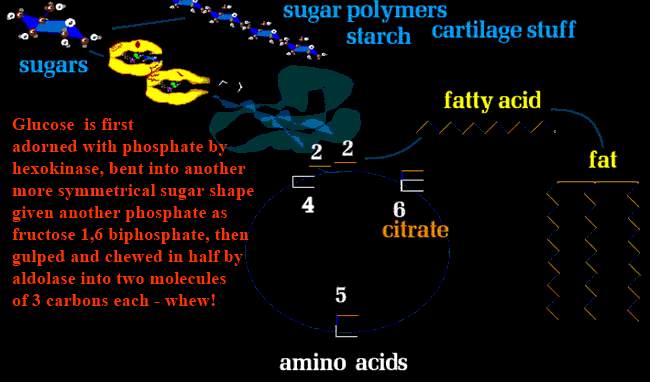
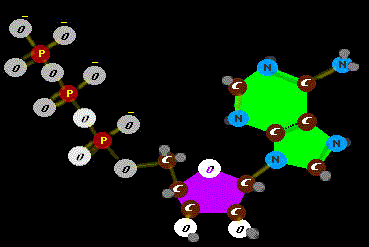
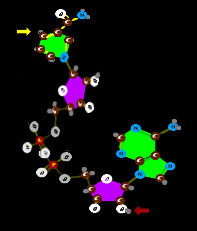 A look at
A look at 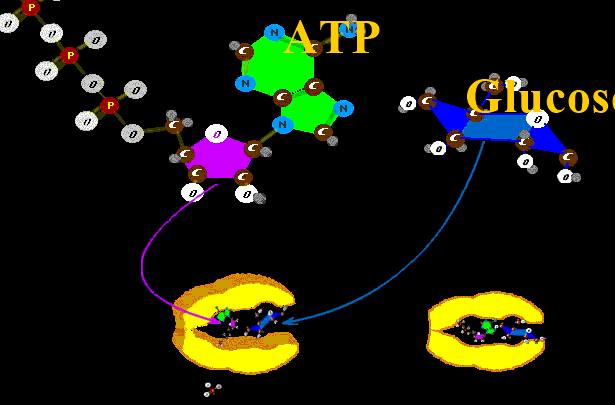

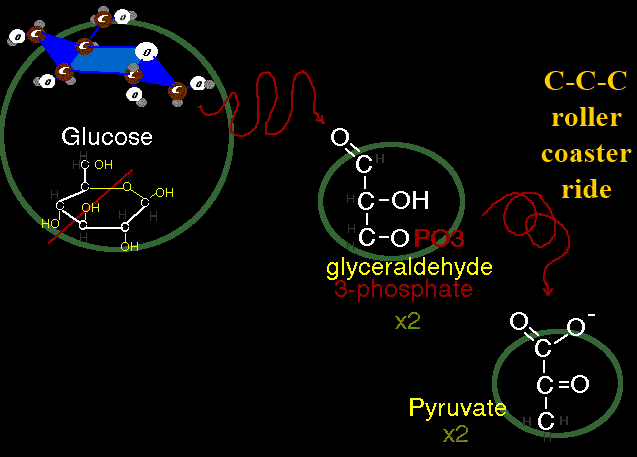
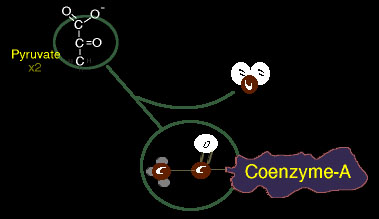 But what a waste. All that carbon just tossed out. That is the key to the citrate cycle, it will burn the fuel gone. It can also get fuel from two other rides, the
great fat slide and from the protein concession stands.
But what a waste. All that carbon just tossed out. That is the key to the citrate cycle, it will burn the fuel gone. It can also get fuel from two other rides, the
great fat slide and from the protein concession stands.